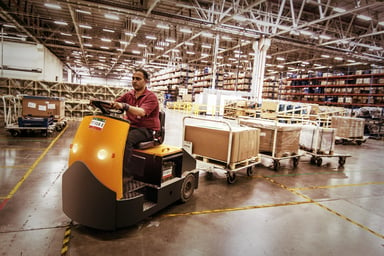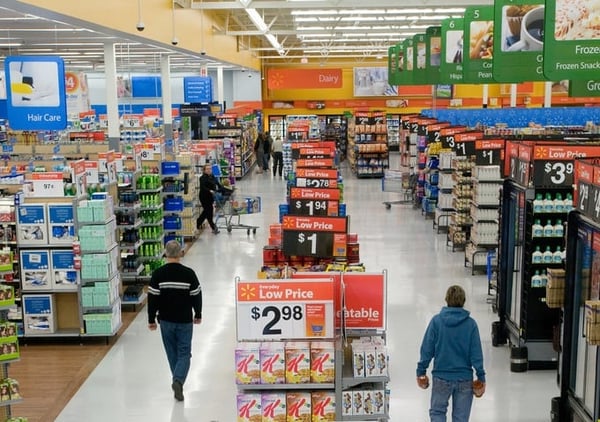If you distribute your consumer goods product through major retail partners like Walmart or Target, you already know the challenging demands those retailers can make of their suppliers. They may place large purchase orders with tight turnaround times, or they could make packaging and design customization requests that strain your workflow.
Club store distribution brings similar demands, but at an even more intense level. The club store experience is all about offering consumers bulk quantity at discount prices. Clubs like Sam’s, Costco, and BJ’s allow their customers to save big by purchasing large volumes of product.
Of course, that value proposition translates back to the supplier in the form of large purchase orders with tight demands. In order to offer those discounted prices, club stores have to carefully manage their margins and cash flow.
They typically don’t want inventory until the very last minute and they expect your product to be retail-ready when it arrives at the store. That is, they don’t want their in-store employees assembling your pop-up display. Your product should be packaged for display upon arrival.
If you don’t have the in-house capabilities to meet these demands or if your packager can’t meet these requirements, you’ll have difficulty succeeding in the club store world. Their business model forces club stores to work with suppliers who are consistent and reliable. Below is an overview of the club store experience, along with some tips on how you can maximize the opportunity.
Club Store Onboarding
Winning shelf space at a club store like Sam’s or Costco is a difficult challenge on its own. However, winning your first purchase order is only half the battle. The second half of the battle is proving that you are reliable and that you deserve to be in the store. If the club loses faith in your ability to deliver, they’ll quickly pull your space and give it to a competitor.
Whitepaper: NEXT LEVEL🔺 Made-To-Measure Packaging Solutions
The process starts with your trial run, which is typically an eight-week period. Over this time, the club will test your product’s sales appeal. The club usually stocks the product in a handful of test stores around the country and they may give you prime shelf space like an endcap or in-aisle display to get your product in front of consumers.
During the trial run, the club evaluates a few factors. One, obviously, is your appeal with consumers. Do club members purchase your product? Appealing packaging plays a critical role in the consumer purchase decision in club stores, and you will likely find that the club itself will have specific thoughts and requests regarding your design.
The club will also analyze your ability to deliver:
- Do your shipments arrive on time and as scheduled? The club doesn’t want the inventory to arrive late, but they also don’t want it early. They want it exactly at the requested delivery time.
- Do your products arrive in retail-ready packaging? For example, if you have an island, the club may want your packaging already stocked in the island display so the store employees can simply wheel the display on a pallet to the final destination. There should be minimal, or even zero, in-store assembly required.
- Are your packaging elements designed with sustainability in mind? The club store doesn’t want to deal with your packaging waste. Things like dunnage or excess material can be viewed negatively during by club stores. Again, their business depends on their ability to suppress costs. If you can help them do that, they will view you more favorably.
- Can you implement changes quickly? During the trial run, the club may want to test different types of packaging. They could ask you to switch from in-aisle displays to endcaps or a specific kind of pop-up. They may want packaging in different shapes and colors. Can you pivot quickly and engineer a new solution?
If you successfully make it through the trial run, you’ll start to receive full purchase orders to distribution through a larger number of store locations. This is a critical time. The challenges of the trial run never really go away. Club stores are always evaluating suppliers and making requests for changes.
The difference after the trial run ends is that the volume increases sharply. You’ll need to quickly ramp up to a high quantity of product, and you’ll still have to deliver on tight deadlines and possibly with challenging customization demands.
If you can meet these challenges, you’ll likely see continued orders in the future, which could boost your revenue, cash flow, and profitability. If you can’t meet the club store’s demands, you may lose your shelf space.
How to Maximize the Club Store Opportunity
Clearly, your packaging plays a critical role in your club store experience. High-quality, appealing packaging can help you catch the eyes of club store consumers. However, your packaging process can help you maintain credibility with the club store and retain your shelf space.
One of the most effective ways to succeed in a club store is to work with a packaging partner who has club store experience. It’s even better if your packager has experience with your specific club. For example, a packager who has delivered to Sam’s in the past will know the Sam’s Club trial run process and their deadlines and customization needs. The packager can then expect and plan for challenges before they even arise.
It’s also important that your packager have the capabilities to produce quickly and to pivot on a moment’s notice. For example, if you use plastic packaging, you may want a packager who has advanced thermoform equipment and capabilities. That way, they can quickly create a new design and produce a new run of packaging, no matter how large or small the volume.
At Deufol, we have our own in-house tooling shop, which helps us create any equipment needed to quickly produce a run of new packaging, even on the tightest deadlines. From our club store experience, we know that packaging needs can run the course from thermoformed plastic to blisters to much more. We can rapidly pivot to meet changing needs.
 Finally, fulfillment is almost as important as the packaging design and production. You’ll likely want to warehouse your product at your packager’s facility to save time. The packager should have sufficient storage space and the capability to pick and pack quickly and efficiently.
Finally, fulfillment is almost as important as the packaging design and production. You’ll likely want to warehouse your product at your packager’s facility to save time. The packager should have sufficient storage space and the capability to pick and pack quickly and efficiently.
Consider a packager who can offer postponed packaging services. This means that they can warehouse your products in their facility and leave that inventory unpackaged until the last minute. This is important because it gives you the flexibility to meet club store order’s for unique mixes of product and packaging. When the order comes in, the packager pulls the required product and bundles and packages it to the custom specifications.
The packager may also need to communicate heavily with your design partner or your in-house marketing team to ensure the products are fulfilled and packed in retail-ready components. Technology can help with this. For instance, you may want a packager who uses software to track the process in real time so you stay updated. Or they could use photo documentation so you can see in real time that the products are packed and displayed correctly.
It pays to do your due diligence before partnering with a packaging company. After all, the quality and efficiency of your packaging product could make or break the outcome of your club store distribution. You worked too hard to win the club store business. Don’t let your packaging derail the opportunity. ![]()






Let Us Know What You Thought about this Post.
Put your Comment Below.